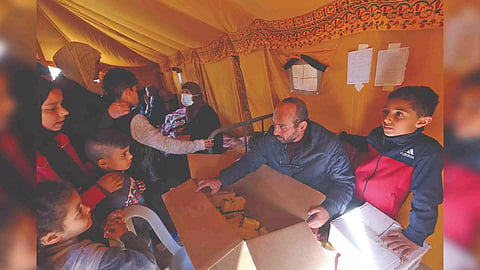

YAHYA R. SARRAJ
As a teenager in the 1980s, I watched the construction of the intricately designed Rashad al- Shawa Cultural Center in Gaza City, named after one of Gaza’s greatest public figures, and its theater, grand hall, public library, printing press and cultural salon.
Students and researchers, scholars and artists from across the Gaza Strip came to visit it, and so did President Bill Clinton in 1998. The center was the gem of Gaza City. Watching it being built inspired me to become an engineer, which led to a career as a professor and, in the footsteps of al-Shawa, as mayor of Gaza City. Now that gem is rubble. It was destroyed by Israeli bombardment.
The Israeli invasion has caused the deaths of more than 20,000 people, according to the Gaza Health Ministry, and destroyed half the buildings in the territory. The Israelis have pulverized something else: Gaza City’s cultural riches and municipal institutions. The unrelenting destruction of Gaza — its iconic symbols, its beautiful seafront, its libraries and archives and whatever economic prosperity it had — has broken my heart.
The Gaza Zoo has been destroyed, with many of its animals killed or starved to death, including wolves, hyenas, birds and foxes. Other casualties include the city’s public library, the Children’s Happiness Center, the municipal building and its archive, and the seventh-century Great Omari Mosque. Israeli forces have also damaged or destroyed streets, squares, mosques, churches and parks.
One of my major goals after the Hamas administration appointed me mayor in 2019 was to improve the city’s seafront and foster the opening of small businesses along it to create jobs. It took us four years to finish the project, which included a promenade, recreation areas and spaces for those businesses. It took Israel only weeks to destroy it. Niveen, a divorced woman I know, was supposed to open a small restaurant in November but her dream is gone. Mohammed, a disabled Palestinian, lost his small cafe.
Why did the Israeli tanks destroy so many trees, electricity poles, cars and water mains? Why would Israel hit a U.N. school? The obliteration of our way of life in Gaza is indescribable. I still feel I am in a nightmare because I can’t imagine how any sane person could engage in such a horrific campaign of destruction and death.
The modern municipality of Gaza was established in 1893 and is one of the oldest in the Middle East. It served about 800,000 people, among the largest congregations of Palestinians in the world. Even after Israel forcibly displaced more than one million Palestinians from northern Gaza after the war began, much of the population in the city remained.
When Israel began its war on Gaza in response to the deadly attack by Hamas, I was abroad. I cut my tour short to return to help our people. I head an emergency committee of municipal workers and volunteers, who have been trying to fix water pipes, open roads and clear disease causing sewage and garbage. At least 14 members of our municipal staff have died. Almost everyone on the committee has lost a home or relative.
I, too, have lost a loved one. Without warning, a direct hit to my house on Oct 22 killed my eldest son, Roshdi, a photojournalist and filmmaker. He thought he would be safer at his parents’ home. It made me wonder if I could have been the target. We will never know. I buried Roshdi and quickly returned to work with the emergency committee. I call on the world’s municipalities — everyone — to pressure world leaders to stop this mindless destruction. Palestinians deserve to be free and have self-determination. Gaza’s emblem is the phoenix, which rises from the ashes. It insists on life.